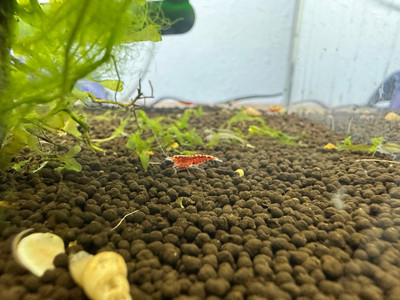Red Pinto Dwarf Shrimp
Posted by Max Gandara on on 29th Jan 2025
The Enchanting World of the Red Pinto Dwarf Shrimp
Welcome to the fascinating universe of the Red Pinto Dwarf Shrimp, a captivating creature that has captured the hearts of aquarists around the globe. Known for their vibrant patterns and petite size, these shrimp are a delightful addition to any freshwater aquarium. In this blog post, we'll dive into everything you need to know about caring for and appreciating these charming crustaceans.
A Closer Look at the Red Pinto Dwarf Shrimp
Appearance and Characteristics
The Red Pinto Dwarf Shrimp, scientifically known as Caridina cantonensis, is renowned for its striking appearance. They boast a vivid red color, often adorned with intricate white patterns resembling the art of a master painter. Their small size, typically measuring around 2.5 to 3 centimeters, makes them perfect for nano tanks and small aquariums.
Natural Habitat
Originally hailing from the streams and rivers of Southeast Asia, these shrimp thrive in environments with clean, soft water. They are accustomed to moderate water flow and plenty of hiding spots, which mimic their natural habitats. In captivity, they require similar conditions to maintain their health and vibrant colors.
Setting Up the Ideal Aquarium
Tank Requirements
- Size: A minimum of 10 gallons is recommended to house a colony of Red Pinto Dwarf Shrimp comfortably.
- Substrate: Dark substrates are preferred as they enhance the shrimp's colors. Sand or fine gravel works well.
- Filtration: Opt for a gentle filter to prevent shrimp from being sucked in. Sponge filters are ideal as they provide a surface for biofilm growth, which shrimp love to graze on.
Water Parameters
Maintaining stable water parameters is crucial for the health of the Red Pinto Dwarf Shrimp:
- Temperature: 68°F to 74°F (20°C to 23°C)
- pH: 6.0 to 6.8
- GH: 4 to 6
- KH: 0 to 2
Plant Life and Decor
These shrimp appreciate a well-planted tank with plenty of hiding places. Consider adding mosses, ferns, and driftwood to provide both shelter and surfaces for biofilm growth. Live plants also help maintain water quality by absorbing nitrates.
Feeding and Nutrition
Red Pinto Dwarf Shrimp are omnivorous scavengers. In the wild, they feed on biofilm, algae, and detritus. In an aquarium setting, a varied diet is essential:
- Prepared Foods: High-quality shrimp pellets or granules
- Vegetables: Blanched spinach, zucchini, or cucumber slices
- Protein: Occasional treats like bloodworms or daphnia
Ensure you remove any uneaten food to prevent water quality issues.
Breeding and Behavior
Breeding Red Pinto Dwarf Shrimp can be a rewarding experience. They are relatively easy to breed if optimal conditions are met. Females will carry clusters of eggs under their abdomen for about 30 days before releasing fully-formed juvenile shrimp. Providing plenty of hiding spots and a stress-free environment is key to successful breeding.
Common Challenges and Tips
- Water Quality: Regular water changes and monitoring parameters are essential to prevent stress and disease.
- Compatibility: Avoid aggressive or large fish that might prey on the shrimp. Ideal tank mates include small, peaceful fish like tetras or other dwarf shrimp species.
- Colony Health: Keep an eye out for signs of stress or illness, such as lethargy or discoloration, and address issues promptly.
Conclusion
The Red Pinto Dwarf Shrimp is a wonderful addition to any freshwater aquarium, offering both beauty and intrigue. With the right care and environment, they can thrive and even multiply, bringing joy and fascination to aquarists young and old. Whether you're a seasoned shrimp keeper or a curious beginner, these captivating creatures are sure to enhance your aquatic experience.

